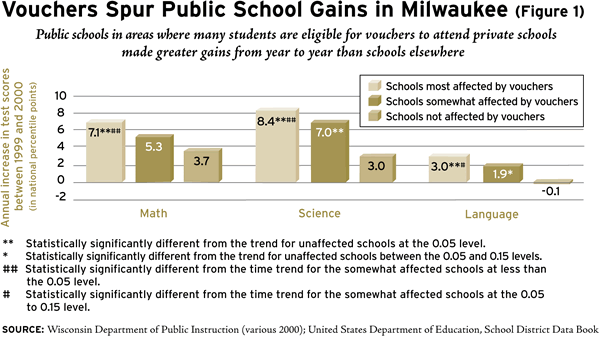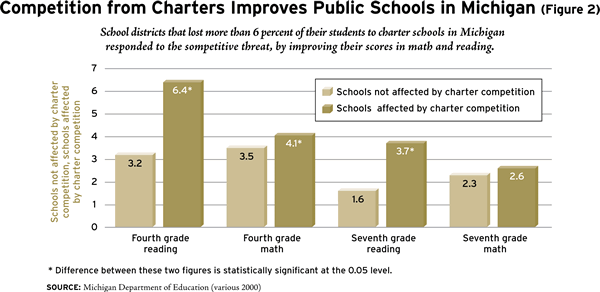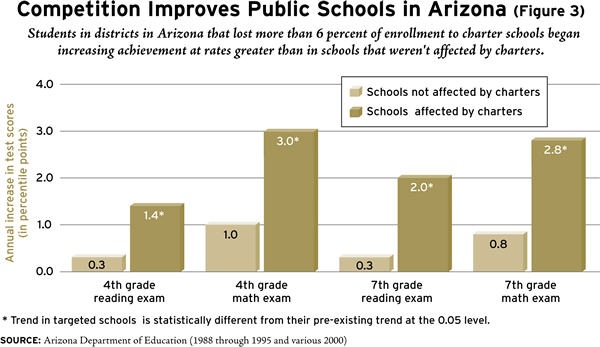
The most scathing critique of voucher programs and charter schools is that they may bleed traditional public schools of their best students and most active parents, leaving the children who are left behind even worse off. Moreover, as the students leave, taking their per-pupil funding with them, the public schools will find themselves stripped of the human and monetary resources necessary to answer the call of competition. “Skimming,” the term of art for this hypothetical phenomenon, may lower overall achievement, as the downward spiral of the public schools swamps any gains made by the students who take advantage of school choice.
Market enthusiasts have always argued the very opposite: that competition will improve the public schools, just as the entry of Federal Express and DHL into the package-delivery market forced the U.S. Postal Service to lower its costs and offer new services, such as Express Mail. Few analysts expected the Postal Service to be able to compete with its new rivals, yet several decades later it is a worthy opponent. Supporters of school choice believe that public school administrators and teachers would respond with equal vigor to the prospect of seeing their students and funding walk out the front door. Their professional pride and livelihood in jeopardy, they would work harder, adopt more effective curricula, hire more talented staff, and turn the district office into more of a support center than a maker and enforcer of rules. They would be spurred to innovate in ways that improve student achievement and parental satisfaction. Competition would be the proverbial rising tide that lifts all boats.
For the most part, the research is in on the question of whether students in private schools, using a publicly funded voucher or paying tuition, perform better than their peers in public schools after adjusting for all the background characteristics that affect achievement. Studies comparing students in private Catholic schools with students in public school, and students who receive a voucher to attend a private school with those who don’t, show substantial achievement gains as a result of attending a private school. How competition affects the students who remain in public schools, however, is a relatively unstudied question. In the vast majority of cities and states, charter schools and voucher programs are either too young or too limited for the public schools to have responded in any significant way.
Only in one city, Milwaukee, and in two states, Arizona and Michigan, have the new choice reforms created truly fluid education marketplaces for a sustained period. Students in Milwaukee have been using vouchers to attend private schools since the 1990-91 school year, though only in 1998-99 was the cap on the number of voucher students raised from 1 percent of the district’s enrollment to 15 percent. The Milwaukee district loses a significant amount of state aid to the voucher program, enough at least to notice if not to elicit some kind of competitive response. This study examines the trend in student achievement in Milwaukee schools where large shares of the student body are eligible for vouchers.
Both Arizona and Michigan have generous charter school laws, approving their applications more easily and funding them more fully than other states. They were both early converts to the charter movement, and some of their public schools are now suffering noticeable enrollment and funding losses as a result of competition from the charter school sector. This study examines achievement trends in districts and municipalities in both states where charters have captured significant market share. Taken together, the findings presented here, from Milwaukee, Arizona, and Michigan, offer a first glimpse at how public schools are responding to these new forms of school choice. They suggest that the fears of a downward spiral aren’t merely overblown. They’re simply wrong.
Time-Tested Choices
It is important to recognize, before discussing the effects of charters and vouchers on public schools, that these new forms of choice simply add to the varieties of de facto choice already available in many parts of the country. It is not at all unusual for parents in a metropolitan urban area to be able to choose from among many schools and many school districts and from a variety of low-cost private school options. These kinds of choice have been around for so long and are so universally taken for granted that we tend not to think of them as choice. But take a family living in the Boston area. They can choose among 70 independent districts located within a 30-minute drive of downtown and many more in the metropolitan area. Towns looking to attract families and raise property values face clear incentives to safeguard the quality of their schools.
Other metropolitan areas offer far less competition among local districts. A family living in Las Vegas, Miami (where one school district, Dade County, covers the entire metropolitan area), or Hawaii (where the entire state is one school district) will be served by the same school district no matter where they choose to reside; the district has a virtual monopoly over public schooling in the area. Comparing public school performance in highly competitive metropolitan areas with performance in less competitive areas is one way of discovering how competition affects public schools.
My research shows that metropolitan areas with maximum interdistrict choice elicit consistently higher test scores than do areas with zero interdistrict choice. The 8th grade reading scores of students in highly competitive areas are 3.8 national percentile points higher than those of students in areas with no competition; their 10th grade math scores are 3.1 national percentile points higher; and their 12th grade reading scores are 5.8 national percentile points higher. Moreover, highly competitive districts spend 7.6 percent less than do districts with no competition. In other words, interdistrict competition appears to raise performance while lowering costs–the result predicted by market enthusiasts.
School districts face competition not only from other school districts but also from private schools. Metropolitan areas vary in this regard as well. Areas with long-standing religious populations, such as Catholics in the Northeast and Lutherans in the Midwest, tend to have developed a large market for private schooling, with many options whose tuition is substantially subsidized by donations of land, buildings, and money given primarily during the first half of the 20th century. Private schools in areas whose religious populations are relatively young or supportive of public schools tend to be less competitive; they simply don’t have the endowments or contributions to keep their tuition low enough to make them accessible to most parents. With strategies similar to those used to analyze the effects of interdistrict choice on public schools, I compared public school performance in areas where public schools face strong competition from private schools with public school performance in areas where little competition between public and private schools exists.
My comparison showed that all schools perform better in areas where there is vigorous competition among public and private schools. Areas with many low-cost private school choices score 2.7 national percentile points higher in 8th grade reading; 2.5 national percentile points higher in 8th grade math; 3.4 national percentile points higher in 12th grade reading; and 3.7 national percentile points higher in 12th grade math.
In short, both traditional forms of choice–choice among school districts and between public and private schools–influence public schools in a positive manner. To place the influence of competition on school performance in perspective, if every school in the nation were to face a high level of competition both from other districts and from private schools, the productivity of America’s schools, in terms of students’ level of learning at a given level of spending, would be 28 percent higher than it is now. And that is with a relatively diluted form of competition; traditional forms of choice do not provide strong competition because money does not follow students in a direct way. Furthermore, traditional forms of choice are not available to many families, either because they live in an uncompetitive area or because they are too poor to move to another district or pay private school tuition.
New Competitors
One advantage of studying traditional forms of school choice is the insight they give into how competition unfolds over the long run–over the many decades traditional forms of choice have been in place. Only the short-term effects of competition can be seen through the study of vouchers, charter schools, and their impact on the public schools against which they compete. Therefore, for this study it was crucial to isolate those instances where competition was lively and long-standing enough to potentially provoke a competitive response from the public schools. As noted earlier, only charter schools in Arizona and Michigan and the voucher program in Milwaukee met this basic criterion.
School vouchers in Milwaukee. In Milwaukee, students from families with incomes at or below 175 percent of the poverty line are eligible for vouchers to attend a private school. For every student using a voucher to leave the Milwaukee public schools, the school loses state aid equal to half the value of the voucher. During the 1999–2000 school year, the year studied here, the voucher was the lesser of $5,106 or the cost of tuition at the private school the student chose. So the district lost $2,553 of its $8,752 in per-pupil spending, or 29 percent, for every student who used a voucher. More than 90 percent of the vouchers went to students in grades 1-7 during 1999-2000 because the vouchers were sufficient to cover tuition only at private elementary schools; high schools tend to charge more. Thus the only public schools in Milwaukee that faced serious competition from the voucher program were elementary schools, so I focused on students’ scores in 4th grade, the only elementary grade in which all Wisconsin students take a statewide exam.
It was not until the cap on the voucher program was raised from 1 percent of the district’s enrollment to 15 percent in the 1998-99 school year that vouchers generated real competition for the public schools. Therefore, it made sense to compare public school performance during the 1996-97 (before significant competition) and 1999-2000 (after significant competition) school years. I divided Milwaukee schools into those that were more “treated” to competition because at least two-thirds of their students were eligible for vouchers, and those that were less treated because less than two-thirds were eligible. I expected that the more-treated schools would respond more strongly than the less treated, but the latter is not a true control group. A full 25 percent of the students in the least-treated schools were still eligible for vouchers. The response of these schools to vouchers might be attenuated, but it would still be a response. To find schools to serve as a true control group, I used the following criteria: 1) the schools were not in Milwaukee (and so entirely unaffected by vouchers); 2) the schools were urban; 3) at least 25 percent of the students were eligible for free or reduced-price lunch; and 4) African-Americans composed at least 15 percent of the student body.
Only 12 schools in Wisconsin met all these criteria. Overall, these schools are still richer and have fewer minority students than the Milwaukee schools. The same is true of the less-treated schools in Milwaukee: they are richer and have fewer minorities than the most-treated schools. Research has shown that these richer schools outside Milwaukee and the less-treated schools in Milwaukee are ordinarily likely to improve more rapidly than the most-treated Milwaukee schools. Put another way, the rates of improvement in the schools facing the most competition from vouchers will probably look less impressive than they actually are. It is simply more difficult for performance to improve in these low-income schools than in the less-treated control group schools.
Given this, the results for Milwaukee’s most-treated schools are remarkable. As shown in Figure 1, 4th-grade math scores rose by about 7 percentile points per year in the most-treated schools, 5 percentile points per year in the less-treated schools, and just 4 percentile points in the control schools. Social-studies scores in the most-treated schools rose by 4.2 percentile points per year, while in control schools the scores rose by only 1.5 percentile points per year. The scores of the students in the most-treated schools, the schools facing the most potential competition from vouchers, improved by more in every subject area tested than did the scores of the students facing less or no competition from vouchers. In fact, though reading scores improved only slightly in the most-treated schools (by 0.6 percentile points per year), reading scores actually dropped in the less-treated schools (by -0.4 percentile points per year) and control schools (by -1.4 percentile points per year), perhaps due to Wisconsin’s adoption of a controversial new “whole language” reading curriculum.

Recall that the most-treated schools were those with the most to overcome in terms of raising their scores, yet they bested the less-treated and untreated schools on every measure of improvement. Their mostly poor and minority students experienced an upward spiral in achievement as a result of competition, and the improvement is even more impressive than the mere comparison of the numbers suggests. Of course, it cannot yet be known how long these schools will be able to maintain their rates of improvement. It is possible that improvement will slow after a few more years of competition.
Charter schools in Michigan. Michigan’s charter school program was established in 1994. It was relatively easy to isolate the schools targeted by competition in Wisconsin: no school outside Milwaukee faced competition from vouchers, and the degree of competition faced by Milwaukee schools varied with students’ poverty. In Michigan, I had to choose a threshold level of charter school enrollment, above which I would classify the neighboring public schools as being subject to charter competition. Because enrollment in Michigan schools normally fluctuates by about 5 percent a year, even when there is no competition from alternative schools, I chose a threshold of 6 percent. That is, I defined a treated public school as any school in a district where charter school enrollment was at least 6 percent of regular public school enrollment.
There are advantages to studying Michigan. For one, a Michigan district that loses a student to a charter school loses a substantial amount of money–the state’s minimum level of per-pupil spending, given the characteristics of the school’s student population. During the 1999-2000 school year, the average spending on a charter school student was $6,600, compared with $7,440 for the average public school student. Also, charter schools in Michigan receive their charters from statewide organizations, such as universities. Unlike charter schools in many other states, they do not have to get their charter approved by the very district that would be their competitor. Big-city, small-city, and small-town schools are all well represented among the schools that face charter competition in Michigan.
As in Milwaukee, achievement improved in Michigan public schools faced with significant competition. As shown in Figure 2, their scores climbed by 2.4 scale points more per year in 4th grade reading and 2.5 scale points more per year in 4th grade math (4th grade is, again, the only elementary grade in which Michigan administers a statewide test). These improvements are above and beyond their achievement trends before they were subject to charter competition. Moreover, they are above and beyond the improvements made during the same period in public schools that did not face charter competition. Just to give a sense of the magnitude of these improvements, one can compare Detroit (a district that did face competition) with one of its most affluent suburbs, Grosse Pointe (a district that did not face competition). If Detroit were to maintain its faster rate of improvement, it would close the achievement gap between its students and Grosse Pointe’s students in just under two decades.

Charter schools in Arizona. Arizona’s charter school law, passed in 1994, is widely regarded as the friendliest to charter schools. It gives charter schools considerable financial and legal autonomy and imposes few constraints on their growth. Consequently, about 5 percent of Arizona’s public school enrollment attended charter schools during the 1999-2000 school year, the highest share of any state in the country. Charter schools in Arizona can be state sponsored, in which case they get a fee equal to the state’s share of revenue (45 percent of the total revenue for a regular public school). They can also be district-sponsored, in which case they get a fee equal to local per-pupil revenue but are less able to compete since they must seek renewal of their charters from the very districts with which they compete.
I followed the same strategy in evaluating Arizona that I used with Michigan, with one exception. A single municipality in Arizona may contain several school districts, so rather than associate regular public schools and charter schools with a district, I associate them with a municipality. As in Michigan, I used charter school enrollment of 6 percent of regular public school enrollment as the threshold for classifying a municipality as facing charter competition. Also, as in Michigan and Wisconsin, I focused on 4th grade scores because it is the elementary grade that has been tested statewide for the longest time.
The results in Arizona were similar to those in Michigan and Milwaukee. As can be seen in Figure 3, regular public schools that faced charter school competition improved both their 4th grade reading scores and their 4th grade math scores by 1.4 national percentile points a year. These improvements are above and beyond their achievement trends before charter competition. They are also larger than the improvements made over the same period by public schools that did not face charter competition. Again, for perspective, let’s compare a municipality that did face charter competition, such as Phoenix, with its affluent suburbs. If Phoenix were to maintain its faster rate of improvement, it would close the achievement gap between its students and those in its affluent suburbs in less than ten years.

Conclusion
The findings presented here consistently show public schools’ responding favorably to competition. In Milwaukee, schools facing more competition from vouchers improved at rates faster than schools facing little or no competition from vouchers. Public schools in Michigan and Arizona began improving at faster rates after they lost significant shares of their enrollment to charter schools. It is risky to extrapolate from these short-term results, but the long-term results found in my studies of traditional competition among districts and between public and private schools seem to confirm that competition is in general good for the public schools.
In fact, say the critics’ worst fears were realized: A school in Milwaukee went from being the best school in the city to the worst as students began leaving on vouchers; an extreme creaming effect took place. The top 10 percent of Milwaukee schools performed 32 percentile points better than the worst 10 percent of Milwaukee schools on Wisconsin’s statewide math exam. Consider a student in this hypothetical school: not only the school’s average score but the student’s score on the statewide math exam dropped 32 points. Even in this case, so bad as to be barely plausible, if the student’s rate of growth in achievement were the same as in the Milwaukee schools that were most treated by voucher competition, after five years the student would be achieving at a higher level than he was before vouchers induced some students to choose a new school.
If one critique can be leveled against these findings, it is the very opposite of skimming: that schools subjected to the most competition might have seen their lowest-performing students leave for charter or private schools. In that case, any achievement gains among the public schools would be at least partly an illusion, simply the result of having lost their worst students to schools of choice. This seems somewhat plausible: the worst students might have highly displeased parents who are eager for new options. But the worst students might also have apathetic parents who could care less. There is no way of knowing. Regardless, those who have studied the test scores and family backgrounds of students switching from public to the new choice schools have found repeatedly that the students are about average, not much different from those left behind. Still, if opponents of school choice wish to stipulate that schools of choice actually attract the worst students, leaving the public schools to teach the so-called cream of the crop, so be it. You’ll get no argument here.
Caroline Minter Hoxby is a professor of economics at Harvard University and a visiting fellow at the Hoover Institution, Stanford University.


